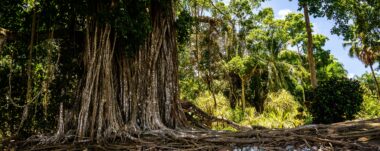COP26: Peaceful and Eco-responsible: Will Costa Rica be the Role Model to Save the Planet?

Our friend, the journalist Benoît Feyt, from belgian TV, RTBF, shared with us this TV report about Costa Rica and COP26. Here is the link and the content in english:
https://www.rtbf.be/info/dossier/le-scan/detail_cop26-pacifique-et-ecoresponsable-le-costa-rica-serait-il-le-modele-a-suivre-pour-sauver-la-planete?id=10870817
Costa Rica is a small country of five million inhabitants nestled in the heart of Central America, bordered by the Pacific Ocean and the Caribbean Sea, covered with volcanoes and tropical vegetation. A small green paradise that attracts every year three million ecotourists conquered by the famous pura vida (healthy life) that reigns there and of which the Costa Ricans are so proud.
It is true that the country has a long tradition of pacifism and eco-responsibility. It abolished the army in 1948 and its wonderful biodiversity has long been protected in national parks that cover almost a quarter of its territory. Aware of its natural wealth, the country invested in sustainable development several decades ago. As a result, 99% of its electricity is now produced by renewable energy sources (hydro, wind, solar, biomass, geothermal). In 2017, the country thus reached a world record by operating for 300 days with green electricity. And the authorities do not intend to stop there.
Zero carbon goal
In 2019, President Carlos Alvarado launched an ambitious program that aims to make Costa Rica the first country in the world to achieve zero carbon emissions by 2050. “Our national decarbonization plan is a roadmap that should allow us to drastically reduce our CO2 emissions in areas such as industry, transportation, construction or even agriculture,” explains Claudia Dobles, the President’s wife, the country’s First Lady. But the actions planned go far beyond the environmental agenda, we see it as a plan for economic and social development that integrates equity, gender equality and the fight against poverty. It’s an extremely ambitious plan!”
This national decarbonization plan has been carefully analyzed by the NGO Climate Action Tracker, which ranks countries according to their positive or negative influence on global warming and Costa Rica’s results seem more than convincing. “This country has been at the forefront of the fight against climate change for almost 10 years, recalls Maria Jose de Villafranca,” climate policy analyst for Climate Action Tracker.
►►► COP26: what commitments have been made ahead of the (expectedly difficult) climate negotiations?
“If all countries were as ambitious, we would certainly be much further along in the fight against global warming. Their national decarbonization plan is not just based on declarations of intent but on a real strategy that includes new regulations and tax incentives. They are tackling the sectors that emit the most carbon, those that pollute the most.
The car, the weak point
To reach the zero carbon objective, Costa Rica will have to reduce the emissions of its large fleet of cars, which is still mostly powered by fossil fuels. Several initiatives have been launched recently to offer alternatives. In the city, where traffic jams are frequent, some municipalities have decided to weave a new network of bicycle paths.
This is the case of Montes De Oca, one of the municipalities of the capital San José. We first have a problem of mentality,” explains Ana Lucia Gonzalez, deputy mayor of the municipality of Montes De Oca. In Costa Rica, buying a car is often the second priority of people after buying a house. They think it is the only way to get around. However, we have a cycling culture in this country where people like to ride their bikes on weekends. But there are still too few Costa Ricans who use soft mobility to get to work. That’s why we’ve created this network of bike paths in several municipalities of San José. We hope that this will encourage more people to abandon the car.”
Car use is indeed a major problem in Costa Rica, where traffic jams almost permanently saturate the roads that connect the main cities of the Central Valley. Unfortunately there are few alternatives at the moment. There is no train line for travelers. Only a fleet of rather old buses allows access to the most remote villages. But it is better not to be in a hurry…
Reducing transport-related emissions is one of the priorities of our national decarbonization plan,” explains Claudia Dobles, the country’s First Lady. Our short- and medium-term goal is to electrify our car fleet as much as possible and to create a multimodal public and private transportation system that can also run on electricity. Since almost 100% of our electricity comes from renewable energy sources, this will significantly reduce our carbon footprint. Then, in the longer term, we plan to integrate green hydrogen as an alternative to electricity.”
Green hydrogen: the fuel of the future?
Costa Rica is indeed home to one of the most ambitious green hydrogen production projects in all of Central and Latin America. This project is being led by Ad Astra Rocket, a company founded by Franklin Chang-Diaz, a Costa Rican physicist and NASA’s first Latin American astronaut. Eight years ago, this company set up shop near the town of Liberia in the province of Guanacaste, which alone produces 40% of Costa Rica’s renewable energy. Its objective: to produce 100% green hydrogen on a single site.
The problem with the vast majority of hydrogen produced around the world today is that it comes from fossil fuels like gas, coal or oil,” explains Juan Del Valle, Director of Operations at Ad Astra Rocket. But here we are producing hydrogen from wind, sun and water.” To accomplish this feat, the company installed small wind turbines and solar panels at its site. The electricity generated is then used to create a water electrolysis effect (electricity flows through water to create a chemical reaction that separates hydrogen and oxygen). The hydrogen is then stored in a recharging station that looks a lot like a gasoline pump. This one allows to recharge in a few minutes a fleet of 4 cars that run 100% on hydrogen. The only vehicles of its kind in Central and Latin America today.
These vehicles do not emit any carbon,” continues Juan Del Valle. The only thing they emit is chemically pure water. It has a little unpleasant taste of plastic but it is completely drinkable (but contains no minerals, and therefore has little nutritional value, ed.) It is therefore a 100% green method from A to Z. For us, green hydrogen is one of the most obvious solutions to reduce the carbon footprint of cars, buses, trucks, ships and even planes. It could also alleviate emissions from highly polluting industries such as steel, cement or ammonia production.” The challenge now is to develop the technology on a larger scale to make it more financially accessible. “Otherwise the public will not follow,” warns Juan Del Valle. But the challenge is worth taking up, and Costa Rica, the land of pura vida, intends to lead by example.
Navigate articles






